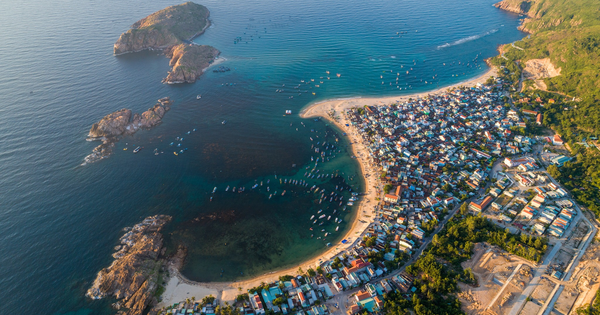Approval of the Planning of the North Central Coast and Central Coast region for the period 2021–2030, with a vision towards 2050 in Vietnam
What are the details of the Planning of the North Central Coast and Central Coast region for the period 2021–2030, with a vision towards 2050 approved by the Prime Minister of Vietnam? - Minh Hai (Binh Thuan)

Approval of the Planning of the North Central Coast and Central Coast region for the period 2021–2030, with a vision towards 2050 in Vietnam (Internet image)
On May 4, 2024, the Prime Minister of Vietnam issued Decision 376/QD-TTg approving the Master Plan for the North Central Coast and Central Coast region for the period 2021–2030, with a vision towards 2050.
Approval of the Planning of the North Central Coast and Central Coast region for the period 2021–2030, with a vision towards 2050 in Vietnam
The Prime Minister of Vietnam approved the planning of the North Central Coast and Central Coast region for the period 2021–2030, with a vision towards 2050 and the following development objectives by 2030:
* General objectives
By 2030, the North Central Coast and Central Coast region will be a rapidly developing, dynamic, and sustainable area with a strong marine economy. The average per capita income of the region will reach a high level. The region will have a comprehensive infrastructure system with a high resilience to natural disasters and effective adaptation to climate change. It will develop several major industrial and service centers in the country, coastal economic zones, and coastal urban systems that meet national and regional standards. It will serve as a gateway to the sea for the Central Highlands region and the Lao People's Democratic Republic. The cultural, historical, and marine, island, and forest ecosystems will be preserved and promoted. The material and spiritual lives of the people will continue to improve, and national defense, security, and maritime sovereignty will be firmly guaranteed.
* Specific objectives and targets
- Regarding economic aspects:
+ Strive for an average annual Gross regional domestic product (GRDP) growth rate of around 7.5–8% during the period 2021–2030. By 2030, the scale of the GRDP will increase 2.5 to 3 times compared to 2020, with the proportion of the service sector reaching about 38–39%, the industrial-construction sector about 40–41%, the agriculture, forestry, and fisheries sector about 10–11%, and product taxes excluding subsidies about 10–11%. The average per capita GRDP at current prices will reach about 165 million VND, equivalent to 6,485 USD.
+ Develop a sustainable urban system with an urbanization rate of over 48%. Strive to develop at least one city at the regional and international level. Build new rural areas comprehensively, sustainably, and in connection with urbanization, with over 90% of communes meeting the new rural area standards, of which 50% will achieve advanced new rural area standards.
+ Develop a digital economy, a circular economy, and a green economy based on enhanced digital and data infrastructure. Strive to achieve a proportion of the digital economy of about 30% of the GRDP by 2030.
- Cultural and social objectives:
+ Continuously improve the spiritual lives of the people, with the Human Development Index (HDI) higher than the national average, gradually narrowing the gap between urban and rural areas, between the plain and mountainous regions, remote and border areas, islands, and coastal areas. Improve the livelihoods of ethnic minority communities.
+ In terms of population and labor: the average annual population growth rate is about 0.9%. Develop a high-quality labor force with appropriate skills for the market, with a focus on industries advantageous to the region. By 2030, the proportion of trained labor will be 75–85%, with 35–40% of trained labor having diplomas or certificates.
+ In terms of education and training: invest in upgrading the infrastructure of educational institutions, strive to achieve national standards for preschool education at about 65-75%, primary education at 75–85%, lower secondary education at 70–80%, and upper secondary education at 60–70% by 2030. Improve the quality of higher education and vocational training, with some disciplines and levels surpassing the national average.
+ In terms of healthcare: build a comprehensive, modern, and efficient healthcare system that meets the needs of protecting, caring for, and improving people's health. By 2030, there will be 35 hospital beds and 15 doctors per 10,000 people.
+ In terms of culture: develop a cultural infrastructure network to effectively preserve and promote the cultural identity of ethnic groups and promote the development of cultural industries. By 2030, 100% of provincial administrative units will have three types of cultural institutions: cultural centers or cultural-art centers, museums, and libraries.
+ In terms of social welfare and poverty reduction: the multidimensional poverty rate will decrease by an average of 1-1.5% per year.
- Regarding environment:
+ Maintain a stable forest coverage rate of 54%; the proportion of households using clean water according to urban standards reaches 100% in urban areas and 80% in rural areas.
+ The proportion of solid waste from urban households collected and treated according to standards and regulations reaches 90%, of which about 40% is processed through circular economic models.
+ The proportion of domestic wastewater collected, treated according to standards, and combined with reuse reaches over 50%; 100% of environmentally polluting facilities are thoroughly treated; 100% of industrial zones and export processing zones in operation have centralized wastewater treatment systems; strive for 100% of economic zones, industrial zones, and coastal urban areas to be planned and built in a sustainable, ecological, smart, and climate change-adaptive manner.
+ Control, prevent, and minimize pollution in coastal, nearshore, and island environments; effectively manage pollution sources from the mainland, and reduce plastic waste by 75% in the sea; 100% of marine conservation areas within the region will be free of sharp waste; 100% of hazardous waste, solid waste, and plastic waste in coastal areas will be collected and treated according to environmental standards.
- Regarding infrastructure development:
+ Develop a synchronized system of technical infrastructure and social infrastructure, including a multi-modal transportation infrastructure network, including North-South and East-West road transportation axes, seaports, airports, and some urban railway lines to connect with the national railway system; by 2030, there will be over 1,554 km of expressways in the region.
+ Develop renewable energy infrastructure (solar energy, wind power, and green hydroelectricity), information and communication infrastructure, urban infrastructure, especially in coastal urban areas, irrigation and flood control infrastructure, and infrastructure adapted to climate change.
- Defense and security: Ensure the firm protection of independence, sovereignty, territory, maritime and island sovereignty; closely integrate economic, cultural, and social development with strengthening defense and security; maintain a peaceful and stable environment, ensuring the order and social security of the region.
More details can be found in Decision 376/QD-TTg, which comes into force from May 4, 2024.
- Number of deputy directors of departments in Vietnam in accordance with Decree 45/2025/ND-CP
- Cases ineligible for pardon in Vietnam in 2025
- Decree 50/2025 amending Decree 151/2017 on the management of public assets in Vietnam
- Circular 07/2025 amending Circular 02/2022 on the Law on Environmental Protection in Vietnam
- Adjustment to the organizational structure of the Ministry of Health of Vietnam: Certain agencies are no longer listed in the organizational structure
- Vietnam aims to welcome 22-23 million international tourists in Vietnam in 2025
-

- Number of deputy directors of departments in Vietnam ...
- 15:04, 05/03/2025
-

- Cases ineligible for pardon in Vietnam in 2025
- 14:43, 05/03/2025
-

- Decree 50/2025 amending Decree 151/2017 on the ...
- 12:00, 05/03/2025
-

- Circular 07/2025 amending Circular 02/2022 on ...
- 11:30, 05/03/2025
-

- Adjustment to the organizational structure of ...
- 10:34, 05/03/2025
-

- Notable new policies of Vietnam effective as of ...
- 16:26, 11/04/2025
-
.Medium.png)
- Notable documents of Vietnam in the previous week ...
- 16:21, 11/04/2025
-
.Medium.png)
- Notable documents of Vietnam in the previous week ...
- 16:11, 02/04/2025
-
.Medium.png)
- Notable new policies of Vietnam to be effective ...
- 16:04, 02/04/2025
-
.Medium.png)
- Notable new policies of Vietnam effective from ...
- 14:51, 21/03/2025

 Article table of contents
Article table of contents
